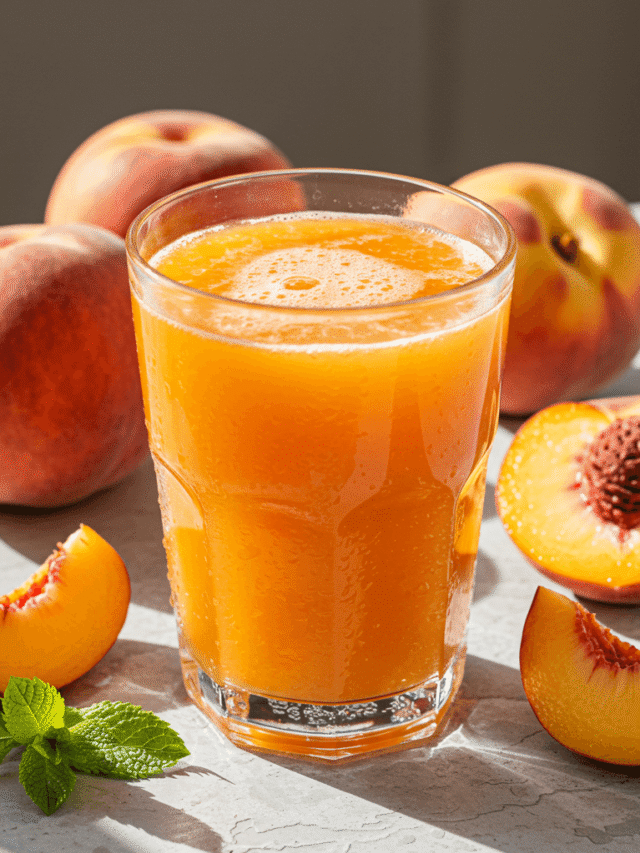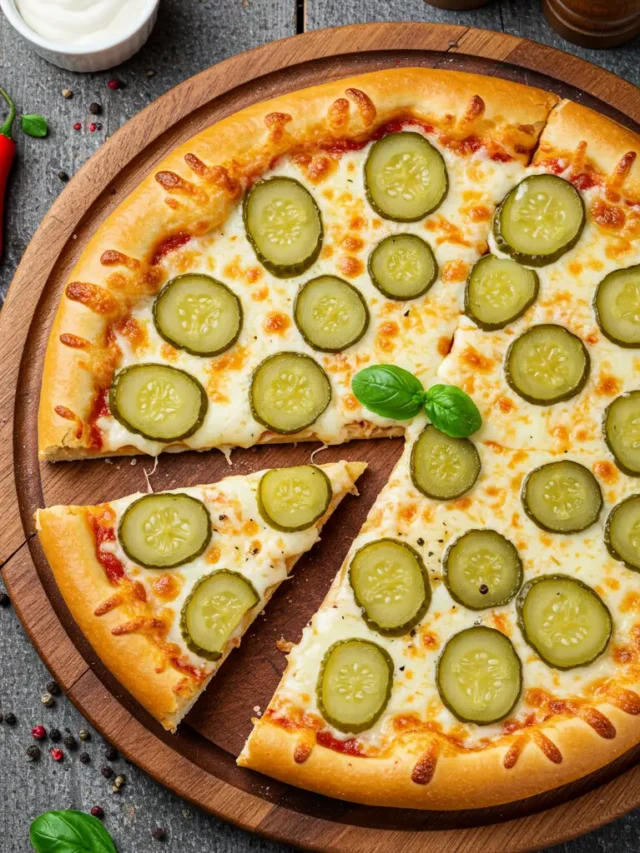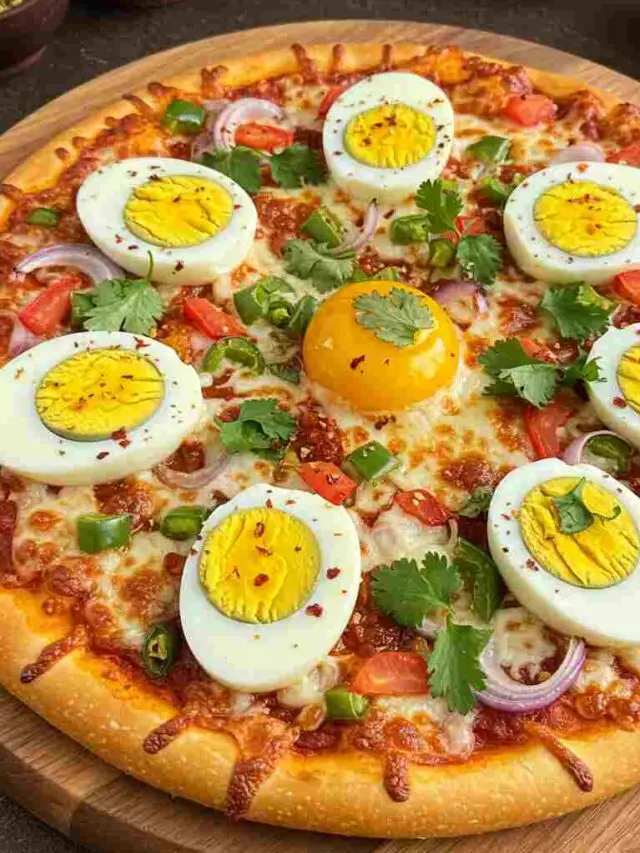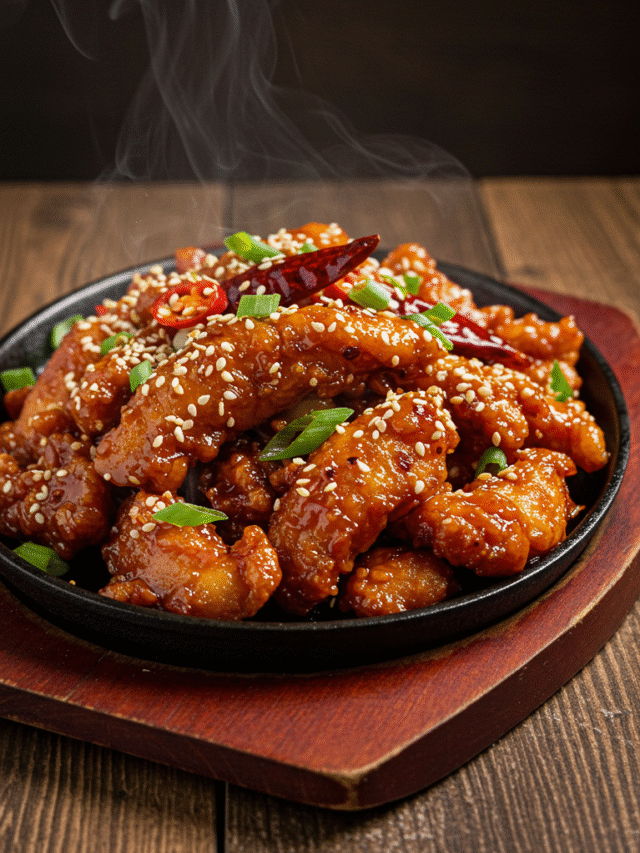Origins of America’s First Fast Food Chain
White Castle changed American dining forever when it opened in 1921. Walter Anderson and Billy Ingram started their revolutionary burger business in Wichita, Kansas. These two men had a simple but powerful idea – make burgers fast, cheap, and the same every time.
Before White Castle, people ate burgers at local diners where every cook made them differently. Anderson and Ingram wanted to create something new. They developed the evolution of American fast food culture that we know today. Their standardized burger system meant customers got the exact same taste at every location – the foundation of what would inspire today’s white castle burger recipe recreations.
The partnership between Anderson and Ingram worked perfectly. Anderson knew how to cook burgers, while Ingram understood business. Together, they created the professional steam cooking methods that made their burgers unique. This combination of culinary skill and business sense launched the fast food industry.
The White Castle model became the template for every fast food chain that followed. McDonald’s, Burger King, and Wendy’s all borrowed ideas from this original concept. The founders proved that Americans wanted quick, affordable meals they could trust – and it all began with what many now consider the original white castle burger recipe.
The Birth of the Slider
Small square patties became White Castle’s signature long before anyone called them “sliders.” Anderson discovered that tiny burgers cooked faster and cost less to make. He created the perfect size – small enough to eat in just a few bites, now famously imitated in many white castle burger recipe guides.
The steam cooking method made these little burgers special. Instead of grilling them like other restaurants, White Castle steamed their patties over a bed of onions. This technique kept the meat juicy and gave it a unique flavor that customers loved.
Anderson designed special equipment for his restaurants. The grills had small holes that let steam rise up through the patties. This proper ground beef handling and cooking temperatures method cooked the burgers evenly and safely – details that home cooks now try to replicate when following a white castle burger recipe.
Mass production techniques helped White Castle serve customers quickly. Workers could make dozens of burgers at once using the same tools and methods. This speed attracted busy workers who needed fast lunches.
The square shape wasn’t just for looks. Square patties fit perfectly on square buns and cooked more evenly than round ones. The five holes in each patty helped steam penetrate the meat, cooking it faster and more thoroughly.
What made White Castle sliders different:
- Steam cooking instead of grilling
- Square shape for even cooking
- Five holes for better steam penetration
- Onion bed for extra flavor
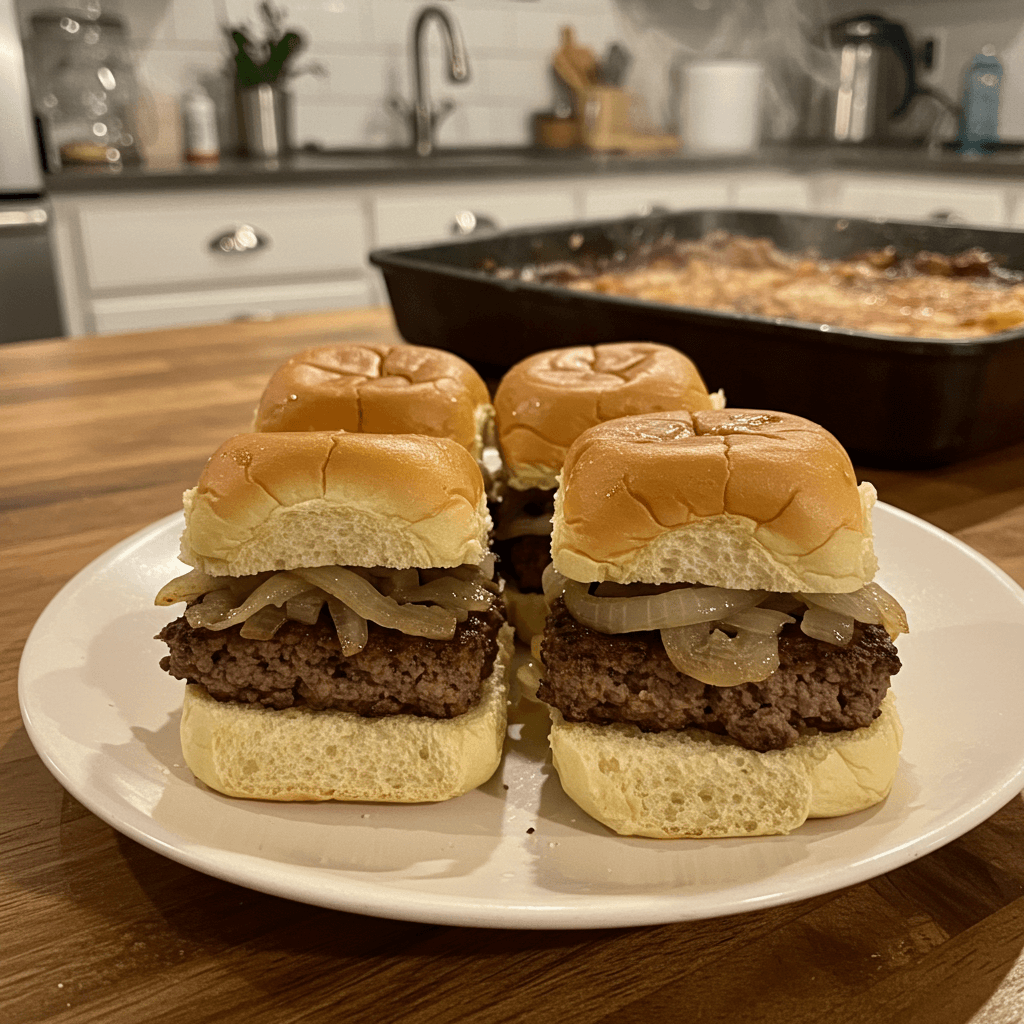
Cultural Impact and Popularity
White Castle burgers became more than just food – they became part of American culture. Families made late-night trips to buy “sacks” of sliders for special occasions. The small size meant people could eat several burgers without feeling too full, which is why many fans look for the best white castle burger recipe to enjoy them at home.
Movies and TV shows started featuring White Castle in their stories. The 2004 movie Harold and Kumar Go to White Castle made the chain famous with younger audiences. This pop culture presence introduced new generations to the slider experience.
The chain built a loyal following in the Midwest and East Coast. Regional burger traditions developed around White Castle locations. Some families have been eating there for four generations, passing down their love for these tiny burgers – and even their homemade versions of the white castle burger recipe.
Generational burger traditions connect grandparents with grandchildren over shared meals. Many people remember their first White Castle experience as children and later bring their own kids to try sliders. This emotional connection keeps customers coming back year after year.
The distinctive taste creates strong memories that last decades. People who move away from White Castle regions often crave the unique flavor. The company now ships frozen sliders nationwide to satisfy these cravings – but for some, only a fresh white castle burger recipe at home will do.
Signs of White Castle’s cultural impact:
- Featured in major Hollywood movies
- Multi-generational family traditions
- Strong regional loyalty
- Nationwide shipping for relocated fans
- Growing interest in authentic white castle burger recipe replications
What Makes White Castle Burgers Unique
The Distinctive Cooking Method
Steam grilling sets White Castle apart from every other burger restaurant. Most fast food chains cook their patties on flat grills with direct heat. White Castle uses a completely different approach that creates their signature taste and texture.
The onion bed cooking process starts with spreading diced onions across the grill surface. Cooks place the small square patties directly on top of these onions. This method allows the burger to cook from steam rising up through the meat rather than just heat from below—an essential element in replicating any authentic white castle burger recipe.
Water gets added to the grill during cooking, creating even more steam. The steam cooking technique keeps the meat incredibly moist while infusing it with onion flavor. This process takes only a few minutes but creates a taste that people remember for years.
Temperature control matters greatly for perfect results. The grill stays at exactly 350°F throughout the cooking process. Timing specifications require flipping the patties after exactly 30 seconds, then cooking for another 60 seconds on the other side.
The steam method cooks the meat more gently than traditional grilling. This gentler heat prevents the outside from getting too crispy while keeping the inside juicy. The result is a tender, flavorful burger that melts in your mouth—one of the many reasons why the white castle burger recipe is so widely imitated.
• Key elements of White Castle’s cooking method:
- Onions spread directly on the grill surface
- Patties placed on top of the onion bed
- Water added to create additional steam
- Precise temperature control at 350°F
- Exact timing for consistent results
Signature Ingredients and Components
Specific beef blend makes White Castle burgers taste different from homemade versions. The company uses a particular mix of ground beef that contains exactly the right fat content. This 80/20 ratio of lean meat to fat creates the perfect texture when steam-cooked, and it’s a must for any accurate white castle burger recipe.
Martin’s potato rolls serve as the official buns for every White Castle slider. These small, square buns have a slightly sweet taste that complements the savory beef. The potato flour in these buns makes them softer and more tender than regular hamburger buns.
Many people wonder about the onions used in White Castle kitchens. The chain uses rehydrated onions instead of fresh ones in most locations. These dried onions get mixed with water before cooking, creating a consistent texture and flavor that doesn’t vary by season—something home cooks try to replicate when attempting a true white castle burger recipe.
The simplicity of ingredients makes White Castle special. Each burger contains only ground beef, onions, salt, and pepper. No fancy seasonings or sauces mask the natural flavors. This minimalist approach lets the steam cooking method shine through.
Quality control keeps every ingredient exactly the same at every location. The beef comes from approved suppliers who meet strict standards. The buns arrive fresh from Martin’s bakery facilities. Even the onions follow precise specifications for size and moisture content.
• Essential White Castle ingredients:
- 80/20 ground beef blend from approved suppliers
- Martin’s potato rolls exclusively
- Rehydrated onions for consistency
- Simple salt and pepper seasoning only
- No additional sauces or seasonings
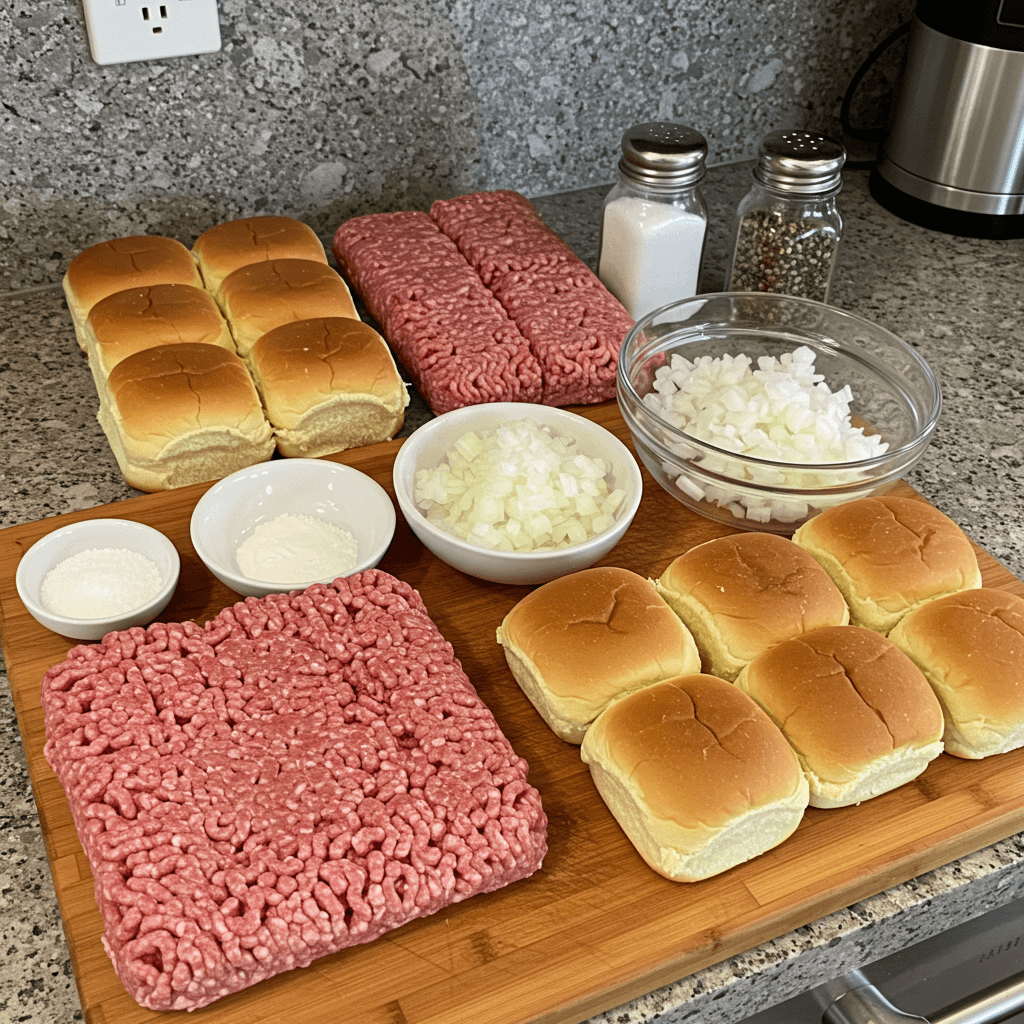
The Secret Behind the Flavor Profile
Furfuryl alcohol compound creates the distinctive smell and taste that White Castle fans recognize instantly. This natural chemical forms when onions cook at high temperatures with steam. The compound gives the burgers their unique aroma that you can smell from the parking lot—a detail often noted in copycat white castle burger recipe guides.
The natural flavor development happens during the steam cooking process. As onions heat up under the beef patties, they release sugars that caramelize slightly. These caramelized onions create sweet notes that balance the savory beef flavor perfectly.
Umami characteristics come from the combination of beef fat, onions, and steam. Umami is the fifth taste (along with sweet, sour, salty, and bitter) that makes food taste rich and satisfying. The long, slow interaction between meat juices and onions during steaming builds these deep, savory flavors—crucial to any white castle burger recipe that aims to taste authentic.
The cooking method concentrates flavors instead of letting them escape. Traditional grilling allows juices and aromas to drip away or evaporate. Steam cooking traps these flavors inside the burger, making every bite more intense than regular hamburgers.
Chemical reactions between proteins and sugars create additional flavor compounds during cooking. These Maillard reactions happen at lower temperatures during steaming, producing different tastes than high-heat grilling. The result is a more complex flavor profile in a simple burger.
Essential Ingredients for Homemade White Castle Burgers
Meat Selection and Preparation
80/20 ground beef creates the perfect texture for homemade White Castle sliders. This ratio means 80% lean meat and 20% fat content. The fat keeps the tiny patties moist during the quick steam cooking process and is essential in any white castle burger recipe.
Choose freshly ground beef from your local butcher or grocery store. Avoid lean ground beef like 90/10 or 95/5 ratios. These lean options will make dry, tough sliders that taste nothing like the original. The fat content melts during cooking and creates the juicy texture White Castle fans love — a must-have detail in a faithful white castle burger recipe.
Proper grinding techniques matter when you grind your own beef at home. Use chuck roast or a mix of chuck and sirloin for the best flavor. Cut the meat into small cubes before grinding. Keep everything cold during the grinding process to prevent the fat from smearing.
Ground beef should look slightly coarse, not like a smooth paste. Over-grinding creates a dense texture that won’t steam properly. The meat should hold together when formed into patties but still have visible small pieces of beef and fat.
Seasoning requirements stay simple for authentic White Castle taste. Use only salt and black pepper — nothing else. Add about 1/2 teaspoon of salt and 1/4 teaspoon of pepper per pound of ground beef. Mix the seasonings gently into the meat without overworking it. This simplicity is what sets a true white castle burger recipe apart from overcomplicated homemade sliders.
• Ground beef specifications for sliders:
- 80% lean meat, 20% fat ratio only
- Freshly ground from chuck roast or chuck/sirloin mix
- Coarse grind texture, not smooth
- Simple salt and pepper seasoning only
- Keep meat cold during all preparation steps
Bun Requirements
Martin’s potato rolls are the gold standard for authentic White Castle sliders. These small, square buns have a unique texture that comes from potato flour in the recipe. The potato flour makes them softer and slightly sweet compared to regular hamburger buns — a crucial element when following a true white castle burger recipe.
Finding Martin’s rolls can be challenging outside of White Castle’s main regions. Look for them in the bread aisle of major grocery stores. Some stores keep them in the specialty bread section or near the deli counter. The package will clearly say “Martin’s Famous Potato Rolls” on the front.
Alternative bun options work when you can’t find Martin’s rolls. Look for small dinner rolls or slider buns that are about 2 inches square. Hawaiian sweet rolls make a good substitute because they have similar sweetness. Regular hamburger buns work too, but cut them into smaller pieces first.
The buns should be soft and fresh, not stale or dry. Stale buns will fall apart when steamed with the burgers. Fresh buns absorb the steam and onion flavors better, creating the authentic White Castle experience you expect from a quality white castle burger recipe.
Proper bun preparation involves splitting them in half before cooking. Use a sharp knife to cut through the middle horizontally. Don’t toast the buns beforehand — they will get warm and slightly steamed during the burger cooking process.
• Bun selection and preparation tips:
- Martin’s potato rolls are the authentic choice
- Look in bread aisle or specialty sections
- Hawaiian sweet rolls work as substitutes
- Buns must be fresh and soft, not stale
- Split buns in half but don’t toast them
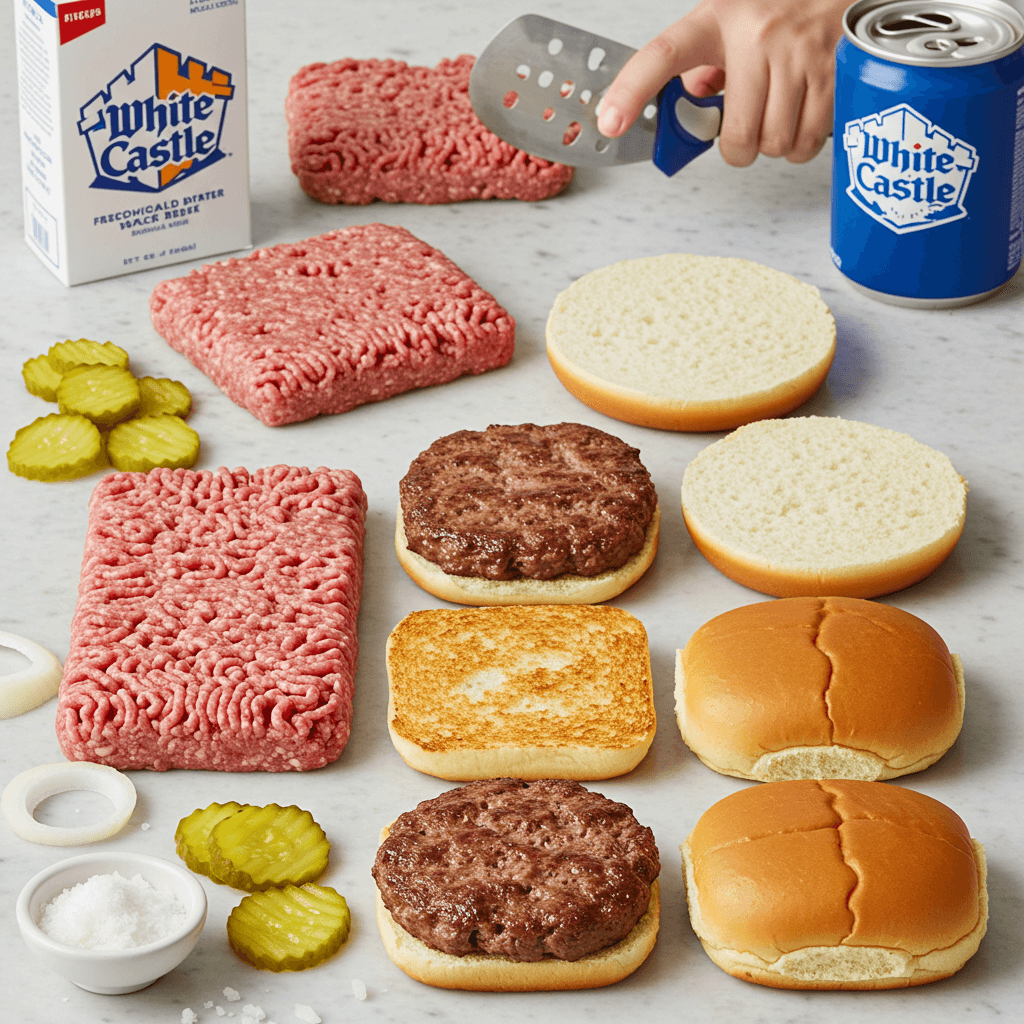
Onion Preparation Secrets
Fresh onions vs rehydrated onions creates debate among White Castle copycat recipe makers. The restaurant chain uses rehydrated dried onions for consistency. Home cooks can use either fresh or dried onions with good results, depending on the style of white castle burger recipe they’re following.
Fresh yellow onions work perfectly for homemade sliders. Choose medium-sized onions with tight, dry skins. Avoid onions that feel soft or have green shoots growing from the top. Sweet onions like Vidalia work too, but they create a slightly different flavor profile.
Proper dicing techniques create the right size onion pieces for steaming. Cut onions into small, uniform pieces about 1/8 inch in size. These tiny pieces cook quickly and distribute evenly under the burger patties. Larger pieces won’t cook properly in the short steaming time — a common issue in failed white castle burger recipe attempts.
Use a sharp knife for clean cuts that don’t crush the onion cells. Crushed onions release too much juice too quickly, creating soggy burgers instead of properly steamed ones. Keep the diced onions in a bowl until ready to cook.
Quantity ratios matter for authentic taste and texture. Use about 1/4 cup of diced onions for every 4 slider patties. This ratio creates enough onion bed for proper steaming without overwhelming the beef flavor. Too many onions make the burgers taste more like onion soup than sliders — a mistake avoided in any well-tested white castle burger recipe.
• Onion preparation guidelines:
- Fresh yellow onions or rehydrated dried onions both work
- Dice into uniform 1/8 inch pieces
- Use sharp knife for clean cuts, not crushing
- 1/4 cup diced onions per 4 slider patties
- Keep onions in bowl until ready to cook
Step-by-Step White Castle Burger Recipe
Equipment and Setup
Flat-top grill or large skillet works best for making authentic White Castle sliders at home. A cast iron skillet gives excellent heat distribution and retains temperature well. Electric griddles also work perfectly for cooking multiple sliders at once.
The cooking surface should be large enough to fit at least 8 small patties comfortably. This size allows you to make a full batch without crowding. Crowded patties don’t steam properly and cook unevenly — something every great white castle burger recipe aims to avoid.
Proper temperature settings require medium-high heat on your stovetop or 350°F on an electric griddle. Test the temperature by sprinkling a few drops of water on the surface. The water should sizzle and evaporate within 2–3 seconds when the temperature is correct.
Essential tools include a thin metal spatula for flipping the tiny patties. A regular spatula works too, but thin edges make flipping easier. You’ll also need a small cup for adding water to create steam during cooking — a signature step in the white castle burger recipe method.
Set up your workspace before you start cooking. Have all ingredients ready and within easy reach. Cooking happens quickly, so you won’t have time to search for missing items once you begin.
• Required equipment checklist:
- Large cast iron skillet or electric griddle
- Thin metal spatula for easy flipping
- Small cup for adding water
- All ingredients measured and ready
- Medium-high heat or 350°F temperature
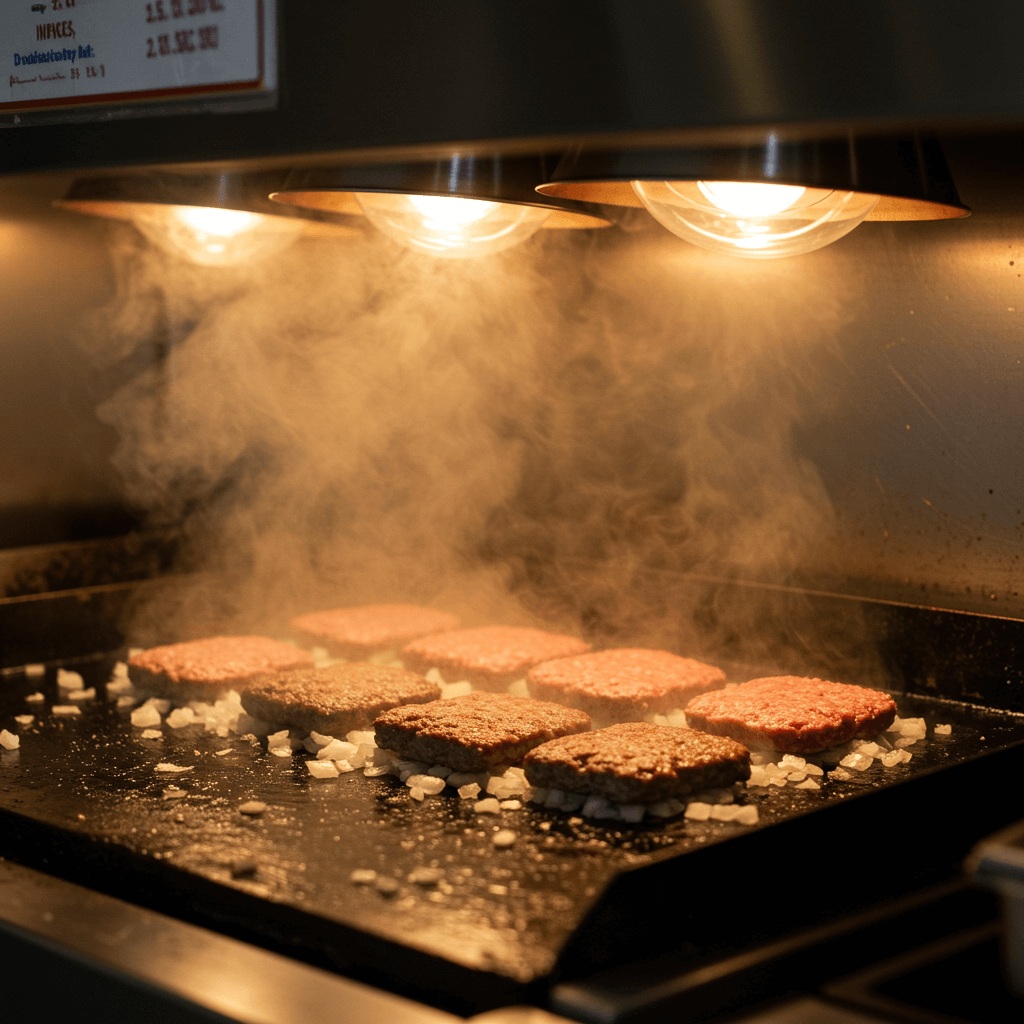
Patty Formation and Preparation
Creating thin, square patties requires gentle handling to avoid tough burgers. Divide your seasoned ground beef into 2-ounce portions. This size matches the original White Castle slider proportions perfectly and stays true to the traditional white castle burger recipe format.
Roll each portion into a ball first, then gently flatten it into a square shape. The patties should be about 2.5 inches wide and 1/4 inch thick. Don’t press too hard or handle the meat too much — this creates dense, chewy burgers that stray from a proper white castle burger recipe.
Proper sizing means all patties should look exactly the same. Use a kitchen scale to weigh each portion if you want perfect consistency. Uniform size makes all the sliders cook at the same rate.
Making the signature holes requires poking 5 small holes in each patty before cooking. Use the end of a wooden spoon or your finger to make holes about 1/4 inch deep. Arrange them with one hole in the center and four holes around it in a square pattern.
These holes aren’t just for looks — they serve an important purpose. The holes allow steam to penetrate the meat more effectively, cooking it faster and more evenly. They also prevent the patties from puffing up during cooking, a key to getting a successful white castle burger recipe result.
Seasoning application happens after forming the patties. Sprinkle a tiny pinch of salt and pepper on both sides of each patty. Don’t over-season — the onions will add plenty of flavor during steaming.
• Patty preparation steps:
- Divide beef into 2-ounce portions
- Form into 2.5-inch square patties, 1/4 inch thick
- Poke 5 holes in square pattern on each patty
- Season lightly with salt and pepper
- Handle meat gently to avoid toughness
The Steam Cooking Process
Creating the onion bed starts the authentic White Castle cooking method. Spread your diced onions evenly across the hot cooking surface. The onions should cover an area large enough for all your patties with a little space between each one.
Let the onions cook for about 30 seconds until they start to sizzle and smell fragrant. Don’t let them brown — you want them to stay light-colored and soft. Browning changes the flavor and makes them too strong for sliders, veering away from the classic white castle burger recipe taste.
Placing patties correctly means setting each one directly on top of the onion bed. Press down gently so the patties make good contact with the onions underneath. The onions should stick to the bottom of each patty.
Add 2 tablespoons of water to the empty spaces around the patties. The water will create steam immediately when it hits the hot surface. This steam cooks the patties from above while the hot onions cook them from below — a cooking method central to any white castle burger recipe.
Adding water for steam needs timing and the right amount. Too much water makes the patties soggy. Too little water doesn’t create enough steam for proper cooking. The water should sizzle and create visible steam clouds.
Timing each cooking stage requires careful attention. Cook the patties for exactly 2 minutes on the first side. You’ll see steam rising around them and the edges will start to look cooked. Don’t flip them too early or they’ll fall apart.
Flip each patty carefully, keeping the onions stuck to the bottom. Cook for another 90 seconds on the second side. Add another tablespoon of water if the steam dies down completely — a small but vital tip for a reliable white castle burger recipe.
• Steam cooking timeline: white castle burger recipe
- Spread onions on hot surface, cook 30 seconds
- Place patties on onion bed, press gently
- Add 2 tablespoons water around patties
- Cook first side exactly 2 minutes
- Flip carefully, cook second side 90 seconds
- Add more water if steam stops
Assembly Techniques
Bun preparation and warming happens during the last minute of patty cooking. Place the bottom halves of your buns around the edges of the cooking surface. The steam and heat will warm them perfectly without making them soggy — just like in a professional white castle burger recipe.
Don’t put the bun tops on the cooking surface — they’ll get too wet from the steam. Keep them nearby and ready to use. Warm buns taste better and absorb the burger juices without falling apart.
Proper stacking order follows the classic White Castle method. Start with the bottom bun, add the patty with onions still attached, then top with the bun top. Don’t add anything else unless you want pickles.
The onions should stay stuck to the bottom of each patty when you transfer them to the buns. If some onions fall off, scoop them up with your spatula and put them back on the burger. These caramelized onions are essential for authentic flavor — the heart of any great white castle burger recipe.
Pickle placement is optional but traditional. White Castle uses small dill pickle chips on their sliders. Place 2–3 pickle chips on top of the patty before adding the top bun. The pickles add a tangy crunch that balances the rich, steamy flavors.
Final presentation tips make your homemade sliders look restaurant-quality. Serve them immediately while still warm and steamy. The buns should be soft and slightly moist from the steam. Each slider should fit easily in one hand for authentic eating.
• Assembly order and tips:
- Warm bottom buns on cooking surface during last minute
- Keep top buns nearby but not on heat
- Stack: bottom bun, patty with onions, pickles (optional), top bun
- Serve immediately while warm and steamy
- Each slider should be small enough for one-handed eating
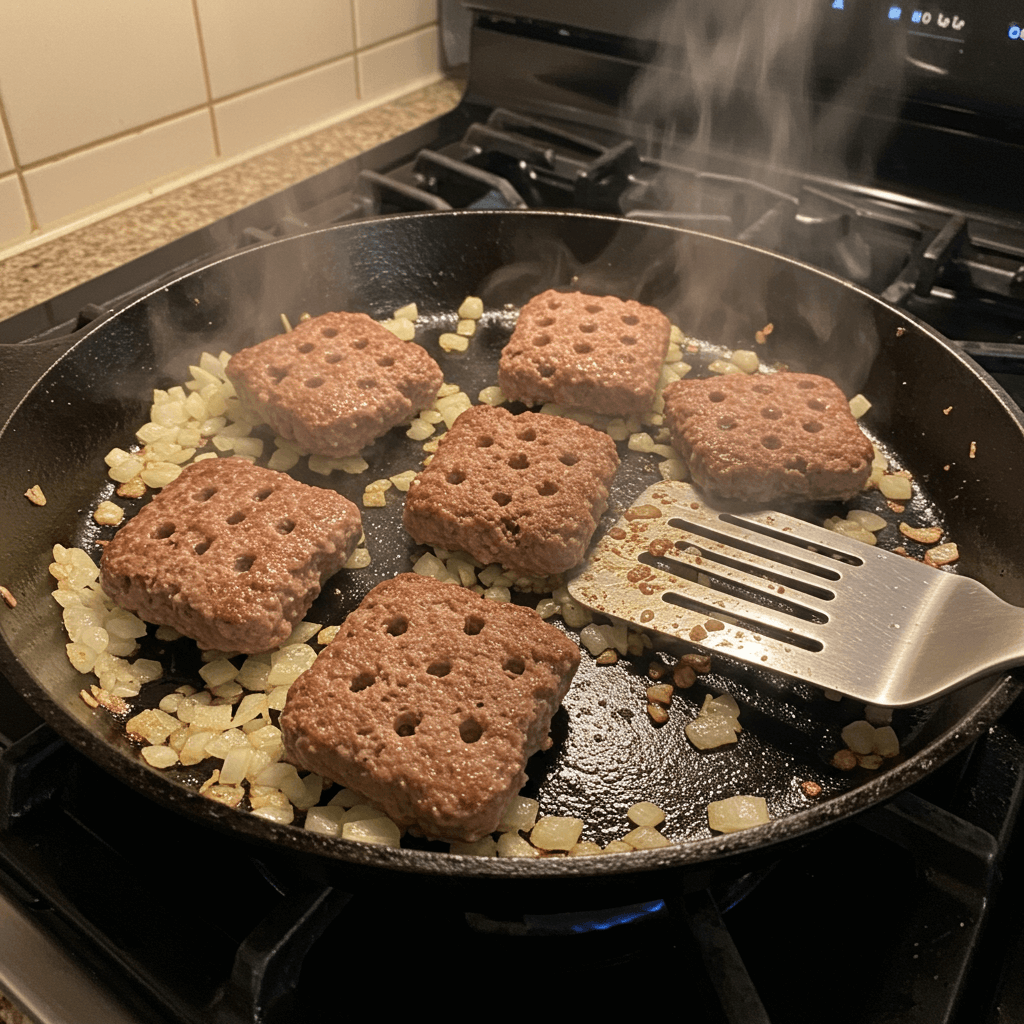
Pro Tips and Troubleshooting
Common Mistakes to Avoid
Overcooking issues ruin homemade White Castle sliders faster than any other mistake. The tiny patties cook much quicker than regular burgers. Many home cooks leave them on the heat too long, creating dry, tough sliders that taste nothing like the original white castle burger recipe.
Watch for visual cues that tell you when the patties are done. The edges should look light gray, not dark brown. Steam should still be rising from the cooking surface. If you see the patties getting dark or the steam stopping completely, they’re probably overcooked.
Improper steam generation happens when cooks don’t add enough water or add it at the wrong time. The water should hit the hot surface and create immediate steam clouds. If the water just sits there without steaming, your cooking surface isn’t hot enough — and this disrupts the delicate balance in a proper white castle burger recipe.
Add water in small amounts throughout the cooking process. One big splash at the beginning won’t create steady steam for the entire cooking time. Keep adding tablespoon-sized amounts as needed to maintain constant steam, just as recommended in every authentic white castle burger recipe.
Patty thickness errors create uneven cooking and wrong textures. Thick patties won’t cook through in the short steaming time. Thin patties fall apart when you try to flip them. The perfect thickness is exactly 1/4 inch — measure with a ruler if needed.
Press the patties gently when forming them. Heavy pressing creates dense, tough burgers that don’t absorb steam properly. Light pressure keeps them tender while still holding together during cooking, which is critical in replicating the white castle burger recipe texture.
• Most common slider-making mistakes:
- Cooking patties too long until they’re dry and tough
- Not adding enough water to create steady steam
- Making patties too thick or too thin
- Pressing meat too hard when forming patties
- Using cooking surface that’s not hot enough
Achieving Restaurant-Quality Results
Temperature control mastery separates good homemade sliders from great ones. The cooking surface needs to stay at exactly 350°F throughout the entire process. Too hot burns the onions and patties. Too cool prevents proper steaming — both of which can ruin an otherwise perfect white castle burger recipe.
Test your temperature regularly by adding drops of water to empty spots on the cooking surface. The water should sizzle immediately and evaporate within 2–3 seconds. If it takes longer to evaporate, increase the heat slightly.
Timing coordination requires practice but makes perfect sliders every time. Start warming your buns during the last 60 seconds of patty cooking. This timing keeps everything hot and ready to serve together — just like a professional white castle burger recipe would recommend.
Cook in batches if you’re making many sliders. Don’t overcrowd the cooking surface trying to make too many at once. Four to six sliders per batch work best for most home cooking surfaces.
Ingredient quality importance affects the final taste more than cooking technique. Fresh ground beef tastes better than beef that’s been sitting in the refrigerator for days. Fresh onions create better steam than old, soft ones — and this freshness elevates any white castle burger recipe.
Buy your ground beef on the same day you plan to cook. Store it in the coldest part of your refrigerator until ready to use. Cold meat holds together better when forming patties and cooks more evenly.
• Keys to restaurant-quality homemade sliders:
- Maintain steady 350°F cooking temperature
- Time bun warming with final minute of cooking
- Cook in small batches, don’t overcrowd
- Use freshest possible ingredients
- Buy ground beef same day as cooking
Storage and Reheating Methods
Proper storage techniques keep leftover sliders fresh for later meals. Let cooked sliders cool to room temperature before storing. Don’t leave them out for more than 2 hours — bacteria grows quickly on cooked ground beef, even when following the best white castle burger recipe methods.
Wrap individual sliders in plastic wrap or aluminum foil. This wrapping prevents them from drying out in the refrigerator. Store wrapped sliders in the refrigerator for up to 3 days maximum.
Best reheating practices bring back the steamy texture that makes White Castle sliders special. Don’t use the microwave — it makes the buns soggy and the meat rubbery. The stovetop method works much better for reheating leftovers made from your favorite white castle burger recipe.
Heat a skillet over medium-low heat. Add a tablespoon of water to the pan and place the sliders inside. Cover the pan with a lid to trap steam. Heat for 2–3 minutes until warmed through.
Make-ahead preparation tips save time when you want fresh sliders for a party or family gathering. Form the patties and dice the onions up to 4 hours ahead of cooking. Keep everything refrigerated until ready to cook — a helpful tip used in many white castle burger recipe guides.
Don’t cook the sliders ahead of time — they taste best when served immediately after cooking. The steamy texture and hot temperature are essential parts of the White Castle experience.
• Storage and reheating guidelines:
- Cool sliders completely before refrigerating
- Wrap individually in plastic wrap or foil
- Store maximum 3 days in refrigerator
- Reheat in covered skillet with water, not microwave
- Prepare ingredients ahead, but cook fresh for best results
Frequently Asked Questions
What are the ingredients in a White Castle burger?
White Castle burgers contain only four simple ingredients: ground beef, onions, salt, and pepper. The patties use 80/20 ground beef formed into small squares with five holes. Diced onions create the steam bed for cooking. Simple salt and pepper provide the only seasoning.
What is the secret to White Castle burgers?
The secret cooking method involves steaming small patties over a bed of diced onions. This steam cooking keeps the meat moist while infusing onion flavor throughout. The five holes in each patty allow steam to penetrate the meat for faster, more even cooking.
Why does White Castle have furfuryl alcohol?
Furfuryl alcohol forms naturally when onions cook at high temperatures. This chemical compound creates the distinctive aroma that White Castle fans recognize immediately. The steam cooking process at 350°F produces this compound, giving the burgers their unique smell and taste.
What makes White Castle burgers different?
Steam cooking over onions makes White Castle completely different from other fast food burgers. Most chains grill their patties with direct heat. White Castle’s indirect steam cooking creates a tender, moist texture that regular grilling can’t achieve. The small size and square shape also set them apart.
Does White Castle use cabbage instead of onions?
No, White Castle uses only onions for their signature cooking method. Some people think they taste cabbage because of the sweet, mild flavor that develops during steam cooking. The onions become very soft and sweet, which might remind some people of cooked cabbage, but they’re definitely onions.
What is on an original White Castle burger?
An original White Castle slider contains just a steamed beef patty with cooked onions on a small potato roll. No cheese, lettuce, tomato, or sauce comes on the basic slider. Some locations offer pickles as an optional topping, but the classic version stays simple with just meat, onions, and bun.
Découvrez Plus de Recettes sur Notre Instagram
Vous aimez cette recette ? Retrouvez encore plus d’idées savoureuses, de conseils en cuisine et d’astuces de préparation directement sur notre page Instagram.
Chaque semaine, nous partageons des photos exclusives, des tutoriels rapides en vidéo et des inspirations pour toutes vos envies culinaires.
👉 Suivez-nous ici : @todarecipes sur Instagram
📲 Ne manquez plus aucune nouveauté gourmande !
En vous abonnant, vous rejoignez une communauté de passionnés de cuisine et vous aurez accès à du contenu unique qui ne figure pas toujours sur le blog.


